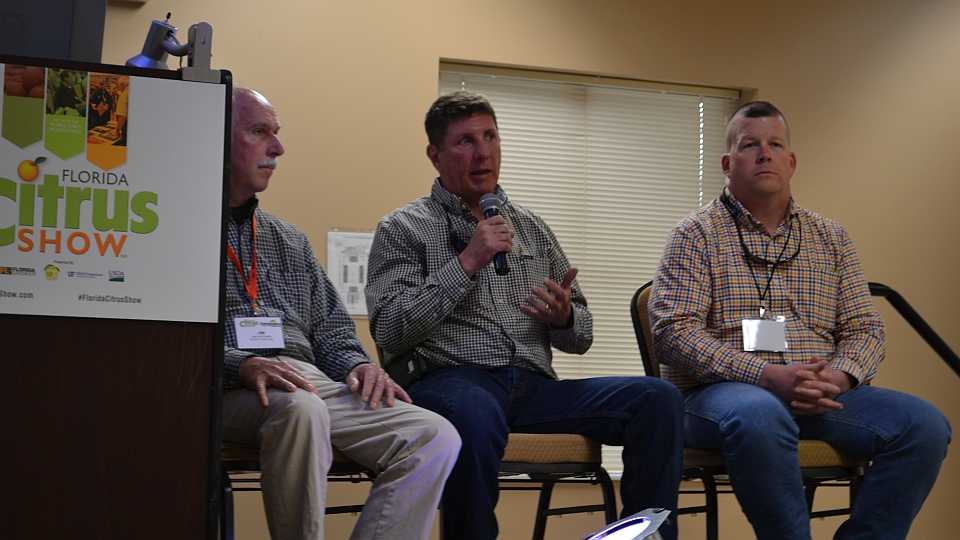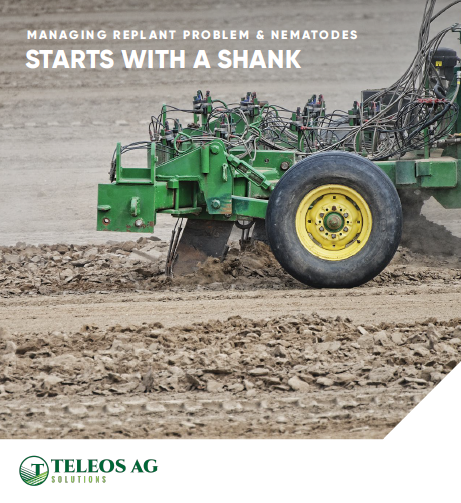Florida Citrus Growers Not Backing Down from Destruction or Disease

2018 Florida Citrus Show grower panel participant Jim Snively of Southern Gardens Citrus said the industry is in uncharted waters in the wake of Hurricane Irma, given this is the first major hurricane since HLB’s onset. “After [Hurricane] Wilma, it took us two crops to recover — and those trees were healthy.” Other panelists included Jim Hoffman of Estes Citrus (left) and Rob Atchley of Duda Citrus.
Photo by Paul Rusnak
Speaking of the weather, Kevin Rodriguez from NOAA’s National Weather Service in Melbourne gave an interesting presentation on the history of hurricane’s in Florida and on the Treasure Coast. His bottom line is there has been a lot of them in the past century and a half, and Florida’s geography poking out into the Atlantic and edging the Gulf makes the state more susceptible to hits than other places. But, hurricane activity is cyclical in nature, and we have had good and long runs without any impacts.
In fact, in the Indian River region where the Citrus Show is hosted, there was a run from 1964 to 1995 with only one hurricane impacting that region. Obviously, the 2004 and 2005 seasons were heavy, but then we went on a decade-plus run of no activity. That ended with Hurricanes Hermine, Matthew, and Irma. The fact that Irma ranks as the fifth most costly storm to ever hit the U.S. came as no surprise to growers in attendance at the Show. I suspect many of them would rank Irma in at least the top three storms in their world. Seemingly in an active cycle again, we’ll have to be alert and prepared for activity in 2018.
Wait and See
I had the opportunity to host a grower panel during the Show with top-notch producers Jim Hoffman of Estes Citrus, Rob Atchley of Duda Citrus, and Jim Snively of Southern Gardens Citrus. Their groves all experienced a pretty strong lashing from the storm, but didn’t experience the tree damage like that brought on by Hurricane Wilma in 2005.
Hoffman noted their groves in the Indian River area felt winds, but the major impacts there came from rains. He credits windbreaks for helping to prevent crop losses to the storm.
“About 10 years ago, we planted 22 liner miles of windbreak trees around our groves,” Hoffman said. “Where some other local growers might have had losses ranging from 40% to 60%, we feel very fortunate that our crop losses [to wind] was limited to 25%.
“Of course, I did nothing but curse those windbreak trees for the next three weeks after the storm because all we did was nothing but chain saw fallen trees. But, when it was said and done, they preserved our crop.”
Hoffman added the water damage from rain was more pronounced. Estes’ groves received about 22 inches of rain, and other areas around Ft. Pierce had upwards of 30 inches.
“We felt like we dodged a bullet with only 25% crop loss from wind,” he said. “But, within two weeks after the storm, the leaves started curling and yellowing, and fruit drop started up. We had water on the grove for five days and just could not get it off the property. I think the longer-term damage from the storm will be water for us.”
Snively reported Southern Gardens had groves with water issues for two weeks after the storm before they got them down to comfortable levels. Their groves also lost a lot of fruit to wind damage from the storm.
“We had a lot of leaf loss and initial fruit loss after the storm itself,” Atchley said. “But, our biggest fear was water. Going into the storm, we knew the wind would tear things up, but water will kill [trees].”
Atchley said the Duda groves are on land designed to move water off effectively, so they were able to mitigate that damage pretty well.
Tree Response Since Irma
The panelists said that phosphite, copper, and psyllid applications in the weeks after the storm were applied in their groves to protect trees from diseases.
“The trees seemed to respond well; and within two weeks, we had a beautiful flush,” Snively said. “As soon as we could get through the groves, we applied copper and phosphite sprays to help offset any brown rot or other issues. We knew we had the fruit loss from the storm, but felt like we had done pretty good. But, then about a week before Thanksgiving, our trees started going in the other direction. Right now, the trees seem to be going through a bigger stress than we have seen since HLB hit us.”
Snively went on to say he is not sure what to expect from the trees because this is the first major hurricane to hit Florida since HLB was endemic across the state. In addition, Atchley observed that storm impacts seem to be variety related.
“We have some younger Valencia trees that except for the light crop from the fruit that got blown off, it was like they didn’t get the memo on the storm,” he joked. “They have good density in the canopy and look set up to do something decent this year. We have some early-mid varieties that look like they wrote the memo on how bad the storm was, and we wonder what they are going to do.”
Atchley added they would know a lot more about where things stand with setting next season’s crop by spring. “We have a range of some acres that look like they will bounce back and have a nice crop and others it might be a couple seasons,” he said. “We have trees that are beat up on the inside a lot more than we realize from the visual appearance on the outside.”
Canker Colossus
Hurricane Irma spread canker far and wide and is a major concern for growers. The panel said copper sprays were a must in their groves after the storm.
“The storm definitely spread canker into places where we didn’t have it before,” Snively said. “What is interesting was about that time of year all the research says fruit should be past canker susceptibility. Up until the storm, the fruit was pretty clean, but all of sudden after the storm it started showing up on fruit breaking color. I had never seen that before.”
During the Show, USDA’s Dr. Tim Gottwald also presented a model he has built to predict the spread of citrus black spot due to the storm. He says it shows black spot will likely spread, but it may take a couple of years to understand the full extent of it.
Full Steam Ahead
The growers on the panel say their programs will remain aggressive with an emphasis on psyllid and canker control, and plant nutrition with an increasing emphasis on root health. They all agreed they need to ease their trees back into normal production practices without overloading them as the recover from Hurricane Irma.
I wish them and all Florida citrus growers well in the coming season.










